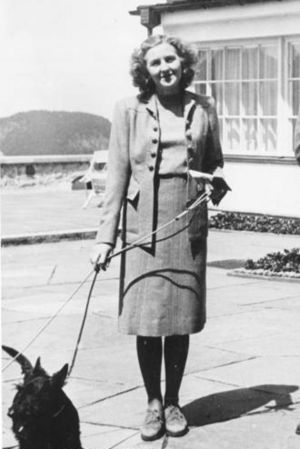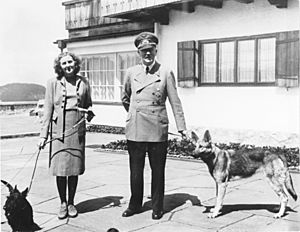Eva Braun facts for kids
Quick facts for kids
Eva Braun
|
|
|---|---|

Braun in 1942
|
|
| Born |
Eva Anna Paula Braun
6 February 1912 Munich, Bavaria, German Empire
|
| Died | 30 April 1945 (aged 33) |
| Other names | Eva Hitler |
| Occupation | Photographer; office and lab assistant at photography studio of Heinrich Hoffmann |
| Known for | Partner and wife of Adolf Hitler |
| Spouse(s) |
Adolf Hitler
(m. 1945; died 1945) |
| Relatives |
|
| Signature | |
Eva Anna Paula Hitler (née Braun; 6 February 1912 – 30 April 1945) was a German photographer who was the longtime companion and briefly the wife of Adolf Hitler. Braun met Hitler in Munich when she was a 17-year-old assistant and model for his personal photographer, Heinrich Hoffmann. She began seeing Hitler often about two years later.
Braun took many of the surviving colour photographs and films of Hitler. By 1936, Braun was a part of Hitler's household at the Berghof near Berchtesgaden, Bavaria, Germany, and lived a sheltered life throughout World War II. She became a significant figure within Hitler's inner social circle, but did not attend public events with him until mid-1944, when her sister Gretl married Hermann Fegelein, the SS liaison officer on his staff.
As Nazi Germany was collapsing towards the end of the war, Braun swore loyalty to Hitler and went to Berlin to be by his side in the heavily reinforced Führerbunker beneath the Reich Chancellery garden. As Red Army troops fought their way into the centre government district, on 29 April 1945, Braun married Hitler during a brief civil ceremony; she was 33 and he was 56. Less than forty hours later, they died by suicide in a sitting room of the bunker: Braun by biting and swallowing a capsule of cyanide, and Hitler by a gunshot to the head. The German public was unaware of Braun's relationship with Hitler until after their deaths.
Early life
Eva Braun was born in Munich and was the second daughter of school teacher Friedrich "Fritz" Braun (1879–1964) and Franziska "Fanny" Kronberger (1885–1976); her mother had worked as a seamstress before her marriage. She had an elder sister, Ilse (1909–1979), and a younger sister, Margarete (Gretl) (1915–1987). Her father was a Lutheran and her mother a Catholic.
Braun's parents were divorced in April 1921 but remarried in November 1922, probably for financial reasons (hyperinflation was plaguing the German economy at the time). Braun was educated at a Catholic lyceum in Munich, and then for one year at a business school in the Convent of the English Sisters in Simbach am Inn, where she had average grades and a talent for athletics.
At age 17, Braun took a job working for Heinrich Hoffmann, the official photographer for the Nazi Party. Initially employed as a shop assistant and sales clerk, she soon learned how to use a camera and develop photographs. She met Adolf Hitler, 23 years her senior, at Hoffmann's studio in Munich in October 1929. He had been introduced to her as "Herr Wolff". Braun's younger sister, Gretl, also worked for Hoffmann from 1932 onward. The women rented an apartment together for a time. Gretl often accompanied Eva on her subsequent trips with Hitler to Obersalzberg.
Relationship with Hitler
Hitler lived with his half-niece, Geli Raubal, in an apartment at Prinzregentenplatz 16 in Munich from 1929 until her death in 1931. Hitler was in Nuremberg at the time. His relationship with Raubal—likely the most intense of his life—had been important to him. Hitler began seeing more of Braun after Raubal's death.
In 1933, Braun worked as a photographer for Hoffmann. This position enabled her to travel—accompanied by Hoffmann—with Hitler's entourage as a photographer for the Nazi Party. Later in her career, she worked for Hoffmann's art press.
Hitler provided Braun and her sister with a three-bedroom apartment in Munich that August, and the next year the sisters were provided with a villa in Bogenhausen at Wasserburgerstr. 12 (now Delpstr. 12). By 1936, Braun was at Hitler's household at the Berghof near Berchtesgaden whenever he was in residence there, but she lived mostly in Munich. Braun also had her own apartment at the new Reich Chancellery in Berlin, completed to a design by Albert Speer.
Braun was a member of Hoffmann's staff when she attended the Nuremberg Rally for the first time in 1935. Hitler's half-sister, Angela Raubal (Geli's mother), took exception to her presence there and was later dismissed from her position as housekeeper at the Berghof. Researchers are unable to ascertain if her dislike for Braun was the only reason for her departure, but other members of Hitler's entourage saw Braun as untouchable from then on.
Hitler wished to present himself in the image of a chaste hero; in the Nazi ideology, men were the political leaders and warriors, and women were homemakers. Hitler believed that women liked him and wished to exploit this for political gain by remaining single, as he felt marriage would decrease his appeal. He and Braun never appeared as a couple in public; the only time they appeared together in a published news photo was when she sat near him at the 1936 Winter Olympics. The German people were unaware of Braun's relationship with Hitler until after the war. Braun had her own room adjoining Hitler's at both the Berghof and the Führerbunker complex beneath the Reich Chancellery garden in Berlin.
Biographer Heike Görtemaker wrote that women did not play a big role in the politics of Nazi Germany. Braun's political influence on Hitler was minimal; she was never allowed to stay in the room when business or political conversations took place and was sent out of the room when cabinet ministers or other dignitaries were present. She was not a member of the Nazi Party. In his post-war memoirs, Hoffmann characterized Braun's outlook as "inconsequential and feather-brained"; her main interests were sports, clothes, and the cinema. She led a sheltered and privileged existence and seemed uninterested in politics. One instance when she took an interest was in 1943, shortly after Germany had fully transitioned to a total war economy; among other things, this meant a potential ban on women's cosmetics and luxuries. According to Speer's memoirs, Braun approached Hitler in "high indignation"; Hitler quietly instructed Speer, who was armaments minister at the time, to halt production of women's cosmetics and luxuries rather than instituting an outright ban. Speer later said, "Eva Braun will prove a great disappointment to historians."
Braun continued to work for Hoffmann after commencing her relationship with Hitler. She took many photographs and films of members of Hitler's inner circle, some of which were sold to Hoffmann for extremely high prices; she received money from Hoffmann's company as late as 1943. Braun also held the position of private secretary to Hitler. This guise meant she could enter and leave the Chancellery unremarked, though she used a side entrance and a rear staircase.
On 3 June 1944, Braun's sister Gretl married SS-Gruppenführer Hermann Fegelein, who served as Reichsführer-SS Heinrich Himmler's liaison officer on Hitler's staff. Hitler used the marriage as an excuse to allow Braun to appear at official functions, as she could then be introduced as Fegelein's sister-in-law. When Fegelein was caught in the closing days of the war trying to escape to Sweden or Switzerland, Hitler ordered his execution. He was shot for desertion in the garden of the Reich Chancellery on 28 April 1945.
Lifestyle
When Hitler purchased the Berghof in 1933, it was a small holiday home on the mountain at Obersalzberg. Renovations began in 1934 and were completed by 1936. A large wing was added onto the original house and several additional buildings were constructed. The entire area was fenced off, and remaining houses on the mountain were purchased by the Nazi Party and demolished. Braun and the other members of the entourage were cut off from the outside world when in residence. Speer, Hermann Göring, and Martin Bormann had houses constructed inside the compound.
Hitler's valet, Heinz Linge, stated in his memoirs that Hitler and Braun had two bedrooms and two bathrooms with interconnecting doors at the Berghof, and Hitler would end most evenings alone with her in his study before they retired to bed. She would wear a "dressing gown or house-coat" and drink wine; Hitler would have tea. Public displays of affection or physical contact were nonexistent, even in the enclosed world of the Berghof. Braun took the role of hostess amongst the regular visitors, though she was not involved in running the household. She regularly invited friends and family members to accompany her during her stays, the only guest to do so.
When Henriette von Schirach suggested that Braun should go into hiding after the war, Braun replied, "Do you think I would let him die alone? I will stay with him up until the last moment". Hitler named Braun in his will, to receive 12,000 Reichsmarks yearly after his death. He was very fond of her, and worried when she participated in sports or was late returning for tea.
Braun was very fond of Negus and Stasi, her two Scottish Terrier dogs, and they appear in her home movies. She usually kept them away from Hitler's German Shepherd, Blondi.
See also
 In Spanish: Eva Braun para niños
In Spanish: Eva Braun para niños



